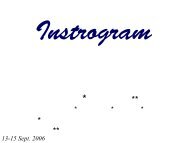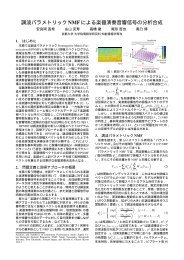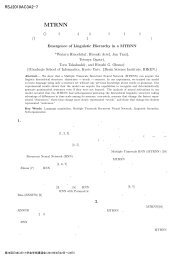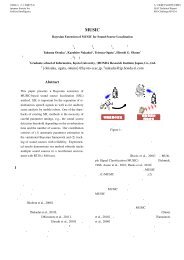第22回 ロボット聴覚特集 - 奥乃研究室 - 京都大学
第22回 ロボット聴覚特集 - 奥乃研究室 - 京都大学
第22回 ロボット聴覚特集 - 奥乃研究室 - 京都大学
Create successful ePaper yourself
Turn your PDF publications into a flip-book with our unique Google optimized e-Paper software.
Aperiodicity rate (APR)TLR (Time-Lag Ratio)Vocal Fry 2 NACR > 1 TLR ≠ 1 Aspiration noise rate (ANR)[9]3.2.3 aspiration noise0.1 VFR > 0.1 c (creaky)APR > 0.1 h(harsh)ANR > 0.1 w (whispery)“breathy voice” m (modal)“whispery voice”3 “turbulent noise”breathy whispery Table 3 Number of utterances of the detected voice [6]qualities, for each perceived speech act group.[13]harsh harsh whispery voice [6][10] F1F3syn (F1 and F3 band synchronization) 1 3 (F1, F3) F1 F3 6 F1F3syn 10 3 A1-A3 F1 F3 (w, hw, h)F1F3syn A1-A3 F3 2 F1 F3 h, hw harsh 3.2.2F1 100 ~ 1500 Hz F3 1800 ~ 4500 Hz [10]c F1F3syn < 0.4 A1-A3 < pc creaky25 dB c creaky F1 band-Amplitudepass filterenvelopeWindowedCross-speech signalA1-A3F1F3syncorrelationF3 band-Amplitudepass filterenvelopeFig. 6 Simplified block diagram of the parameters for F0 aspiration noise detection.harsh creaky F0 F0move F0 3.2.4 4 Vocal fry rate (VFR)Vocal fry (creaky)75
















